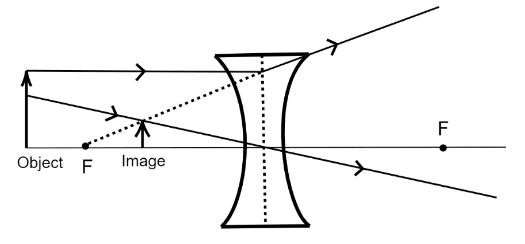
A concave lens always forms an image which is
(A) Real, inverted and diminished
(B) Real, erect and diminished
(C) Virtual, erect and magnified
(D) Virtual, erect and diminished
Answer
557.7k+ views
Hint : Conventionally, the radius of the curvature of the concave lens is always negative. So, the focal length which is numerically half of the radius of curvature is also negative. Using the lens formula, we can calculate the image position and get the answer.
Formula used:
Lens formula is given as
$ \Rightarrow \dfrac{1}{v} - \dfrac{1}{u} = \dfrac{1}{f} $
Where, $ f $ is the focal length of the lens, $ u $ is the object distance, $ v $ is the image distance.
Magnification is given as
$ \Rightarrow m = \dfrac{v}{u} $ .
Complete step by step answer
The ray diagram for a concave lens is given as

The convention of signs is such that, the coordinates on the left side of the lens are taken negative while the coordinates on the right side are taken as positive.
From the ray diagram, we can conclude that the image is erect.
The object distance is always negative.
For a concave lens, the focal length is also always negative.
We know that
$ \Rightarrow \dfrac{1}{v} - \dfrac{1}{u} = \dfrac{1}{f} $
$ \Rightarrow \dfrac{1}{v} = \dfrac{1}{u} + \dfrac{1}{f} $ $ - - - - (1) $
In this case of a concave lens, $ u $ and $ f $ have negative non-zero values.
Thus, under any conditions, $ v $ i.e. image distance is always negative. From this, we can conclude that the image formed will always be virtual.
Magnification is given as
$ \Rightarrow m = \dfrac{v}{u} $
From the equation $ (1) $ , we can observe that the numeric value $ \dfrac{1}{v} $ will always be greater than $ \dfrac{1}{u} $ .
So, we can say that $ v < u $ in every case.
$ \Rightarrow m < 1 $
This implies that the image is always diminished.
Thus, option (D) is correct.
Note
Be careful of the apparatus given in the question. It can be a convex lens or convex mirror or a concave mirror. In each of these cases, we will have different answers. For example, the radius of the curvature of the convex lens is positive. Thus all the values will be different accordingly. It is always better to make a ray diagram and then approach the problem.
Formula used:
Lens formula is given as
$ \Rightarrow \dfrac{1}{v} - \dfrac{1}{u} = \dfrac{1}{f} $
Where, $ f $ is the focal length of the lens, $ u $ is the object distance, $ v $ is the image distance.
Magnification is given as
$ \Rightarrow m = \dfrac{v}{u} $ .
Complete step by step answer
The ray diagram for a concave lens is given as

The convention of signs is such that, the coordinates on the left side of the lens are taken negative while the coordinates on the right side are taken as positive.
From the ray diagram, we can conclude that the image is erect.
The object distance is always negative.
For a concave lens, the focal length is also always negative.
We know that
$ \Rightarrow \dfrac{1}{v} - \dfrac{1}{u} = \dfrac{1}{f} $
$ \Rightarrow \dfrac{1}{v} = \dfrac{1}{u} + \dfrac{1}{f} $ $ - - - - (1) $
In this case of a concave lens, $ u $ and $ f $ have negative non-zero values.
Thus, under any conditions, $ v $ i.e. image distance is always negative. From this, we can conclude that the image formed will always be virtual.
Magnification is given as
$ \Rightarrow m = \dfrac{v}{u} $
From the equation $ (1) $ , we can observe that the numeric value $ \dfrac{1}{v} $ will always be greater than $ \dfrac{1}{u} $ .
So, we can say that $ v < u $ in every case.
$ \Rightarrow m < 1 $
This implies that the image is always diminished.
Thus, option (D) is correct.
Note
Be careful of the apparatus given in the question. It can be a convex lens or convex mirror or a concave mirror. In each of these cases, we will have different answers. For example, the radius of the curvature of the convex lens is positive. Thus all the values will be different accordingly. It is always better to make a ray diagram and then approach the problem.
Recently Updated Pages
A man running at a speed 5 ms is viewed in the side class 12 physics CBSE

The number of solutions in x in 02pi for which sqrt class 12 maths CBSE

State and explain Hardy Weinbergs Principle class 12 biology CBSE

Write any two methods of preparation of phenol Give class 12 chemistry CBSE

Which of the following statements is wrong a Amnion class 12 biology CBSE

Differentiate between action potential and resting class 12 biology CBSE

Trending doubts
What are the major means of transport Explain each class 12 social science CBSE

Which are the Top 10 Largest Countries of the World?

Draw a labelled sketch of the human eye class 12 physics CBSE

Explain sex determination in humans with line diag class 12 biology CBSE

Explain sex determination in humans with the help of class 12 biology CBSE

Differentiate between homogeneous and heterogeneous class 12 chemistry CBSE




